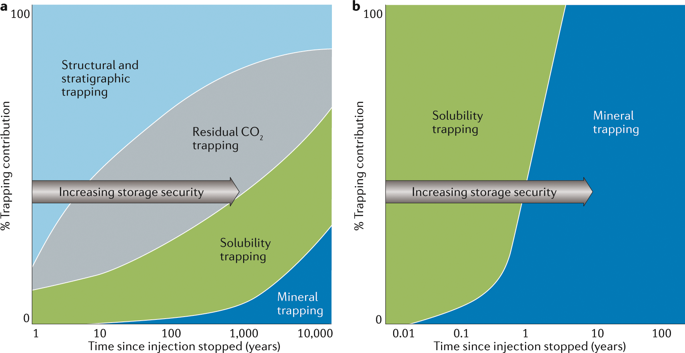Nature Reviews Earth & Environment ( IF 49.7 ) Pub Date : 2020-01-20 , DOI: 10.1038/s43017-019-0011-8 Sandra Ó. Snæbjörnsdóttir , Bergur Sigfússon , Chiara Marieni , David Goldberg , Sigurður R. Gislason , Eric H. Oelkers

|
Carbon capture and storage (CCS) has a fundamental role in achieving the goals of the Paris Agreement to limit anthropogenic warming to 1.5–2 °C. Most ongoing CCS projects inject CO2 into sedimentary basins and require an impermeable cap rock to prevent the CO2 from migrating to the surface. Alternatively, captured carbon can be stored through injection into reactive rocks (such as mafic or ultramafic lithologies), provoking CO2 mineralization and, thereby, permanently fixing carbon with negligible risk of return to the atmosphere. Although in situ mineralization offers a large potential volume for carbon storage in formations such as basalts and peridotites (both onshore and offshore), its large-scale implementation remains little explored beyond laboratory-based and field-based experiments. In this Review, we discuss the potential of mineral carbonation to address the global CCS challenge and contribute to long-term reductions in atmospheric CO2. Emphasis is placed on the advances in making this technology more cost-effective and in exploring the limits and global applicability of CO2 mineralization.
中文翻译:

通过矿物碳酸化储存二氧化碳
碳捕集与封存(CCS)在实现《巴黎协定》的目标中发挥基本作用,该目标将人为变暖限制在1.5–2°C。正在进行的大多数CCS项目都将CO 2注入沉积盆地,并且需要不透水的盖层,以防止CO 2迁移到地表。另外,捕获的碳可以通过注入反应性岩石(例如镁铁质或超镁铁质岩性)中来储存,从而激发CO 2矿化作用,从而永久固定碳,而返回大气的风险可忽略不计。尽管原位矿化为玄武岩和橄榄岩(陆上和海上)等地层中的碳储藏提供了巨大的潜力,但除了实验室和基于现场的实验外,其大规模实施尚无人探索。在这篇综述中,我们讨论了矿物碳化的潜力,以应对全球CCS挑战,并有助于长期减少大气中的CO 2。重点放在使该技术更具成本效益以及探索CO 2矿化的极限和全球适用性方面的进展。







































 京公网安备 11010802027423号
京公网安备 11010802027423号